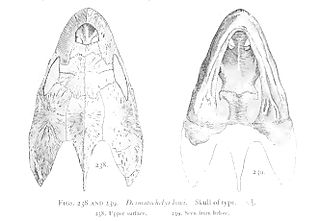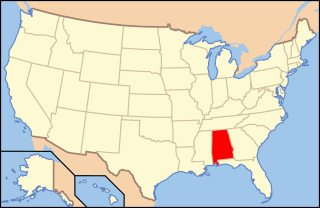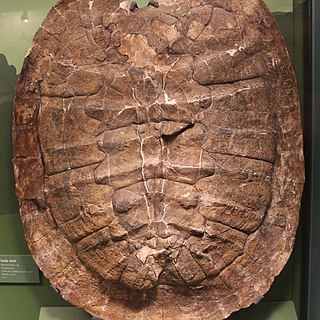
Archelon is an extinct marine turtle from the Late Cretaceous, and is the largest turtle ever to have been documented, with the biggest specimen measuring 4.6 m (15 ft) from head to tail and 2.2–3.2 t in body mass. It is known only from the Pierre Shale and has one species, A. ischyros. In the past, the genus also contained A. marshii and A. copei, though these have been reassigned to Protostega and Kansastega, respectively. The genus was named in 1895 by American paleontologist George Reber Wieland based on a skeleton from South Dakota, who placed it into the extinct family Protostegidae. The leatherback sea turtle was once thought to be its closest living relative, but now, Protostegidae is thought to be a completely separate lineage from any living sea turtle.

Protosphyraena is a fossil genus of swordfish-like marine fish, that thrived worldwide during the Upper Cretaceous Period (Coniacian-Maastrichtian). Though fossil remains of this taxon have been found in both Europe and Asia, it is perhaps best known from the Smoky Hill Member of the Niobrara Chalk Formation of Kansas. Protosphyraena was a large fish, averaging 2–3 metres in length. Protosphyraena shared the Cretaceous oceans with aquatic reptiles, such as mosasaurs and plesiosaurs, as well as with many other species of extinct predatory fish. The name Protosphyraena is a combination of the Greek word protos ("early") plus Sphyraena, the genus name for barracuda, as paleontologists initially mistook Protosphyraena for an ancestral barracuda. Recent research shows that the genus Protosphyraena is not at all related to the true swordfish-family Xiphiidae, but belongs to the extinct family Pachycormidae.

Protostegidae is a family of extinct marine turtles that lived during the Cretaceous period. The family includes some of the largest sea turtles that ever existed. The largest, Archelon, had a head one metre (39 in) long. Like most sea turtles, they had flattened bodies and flippers for front appendages; protostegids had minimal shells like leatherback turtles of modern times.

Bothremydidae is an extinct family of side-necked turtles (Pleurodira) known from the Cretaceous and Cenozoic. They are closely related to Podocnemididae, and are amongst the most widely distributed pleurodire groups, with their fossils having been found in Africa, India, the Middle East, Europe, North America and South America. Bothremydids were aquatic turtles with a high morphological diversity, indicative of generalist, molluscivorous, piscivorous and possibly herbivorous grazing diets, with some probably capable of suction feeding. Unlike modern pleurodires, which are exclusively freshwater, bothremydids inhabited freshwater, marine and coastal environments. Their marine habits allowed bothremydids to disperse across oceanic barriers into Europe and North America during the early Late Cretaceous (Cenomanian). The youngest records of the group are indeterminate remains from Saudi Arabia and Oman, dating to the Miocene.

Ctenochelys is an extinct genus of marine turtle, which existed during the Cretaceous period, and lived in the shallow waters of the Western Interior Seaway. Its fossils have been found in the Ripley Formation and Mooreville Chalk of central Alabama, United States. It was first named by C. H. Sternberg in 1904, and contains two species, C. stenoporus and C. acris.

Toxochelys is an extinct genus of marine turtle from the Late Cretaceous period. It is the most commonly found fossilized turtle species in the Smoky Hill Chalk, in western Kansas.

Desmatochelys is an extinct genus of sea turtles belonging to the family Protostegidae. This genus contains two known species, D. lowii and D. padillai. D. lowii was first discovered in 1895, followed by D. padillai in 2015. Having been estimated at over 120 million years old, D. padillai is currently the oldest known species of sea turtle.
The Mooreville Chalk is a geological formation in North America, within the U.S. states of Alabama and Mississippi, which were part of the subcontinent of Appalachia. The strata date back to the early Santonian to the early Campanian stage of the Late Cretaceous. The chalk was formed by pelagic sediments deposited along the eastern edge of the Mississippi embayment. It is a unit of the Selma Group and consists of the upper Arcola Limestone Member and an unnamed lower member. Dinosaur, mosasaur, and primitive bird remains are among the fossils that have been recovered from the Mooreville Chalk Formation.
The Demopolis Chalk is a geological formation in North America, within the U.S. states of Alabama, Mississippi, and Tennessee. The chalk was formed by pelagic sediments deposited along the eastern edge of the Mississippi embayment during the middle Campanian age of the Late Cretaceous. It is a unit of the Selma Group and consists of the upper Bluffport Marl Member and a lower unnamed member. Dinosaur and mosasaur remains are among the fossils that have been recovered from the Demopolis Chalk.
Anomoeodus is an extinct genus of prehistoric marine ray-finned fish belonging to the family Pycnodontidae. This genus primarily lived during the mid-to-late Cretaceous period, ranging from the Albian to the very end of the Maastrichtian age, and possibly into the Danian. The first fossils of Anomoeodus were described by Louis Agassiz in 1833, although they were described under Pycnodus. Some studies have recovered it as a wastebasket taxon.
Compsemys is an extinct genus of prehistoric turtles from the Late Cretaceous and Paleocene of North America and possibly Europe. The type species C. victa, first described by Joseph Leidy from the Hell Creek Formation in Montana in 1856, and another probable species C. russelli, described in 2012, from Paleocene deposits in France. Its affinites have long been uncertain, but it has recently been considered to be the most basal member of Paracryptodira, despite the clade first appearing in the Late Jurassic, and is sometimes included in its own family, Compsemydidae. A revision in 2020 found Compsemydidae to be more expansive, also containing Riodevemys and Selenemys from the Late Jurassic of Europe, and Peltochelys from the Early Cretaceous of Europe.
The Hornerstown Formation is a Paleogene or latest Mesozoic geologic formation in New Jersey. The age of these deposits have been controversial. While most fossils are of animals types known from the earliest Cenozoic era, several fossils of otherwise exclusively Cretaceous age have been found. These include remains of the shark Squalicorax, several types of non-avian dinosaurs, the teleost fish Enchodus, several species of ammonite, and marine lizards referred to the genus Mosasaurus. Some of these remains show signs of severe abrasion and erosion, however, implying that they are probably re-worked from older deposits. Most of these fossils are restricted to the lowest point in the formation, one rich in fossils and known as the Main Fossiliferous Layer, or MFL. Other explanations for the out-of-place fossils in the MFL is that they represent a time-averaged assemblage that built up and remained unburied during a time of low sediment deposition, or that they were stirred up from deeper in the sediment and deposited together during a tsunami.

Otodontidae is an extinct family of sharks belonging to the order Lamniformes. Its members have been described as megatoothed sharks. They lived from the Early Cretaceous to the Pliocene, and included genera such as Otodus, including the giant megalodon. Recent studies of the newly described genus Megalolamna indicate that the members of the genus Carcharocles should be reclassified as members of the genus Otodus. The genus Cretalamna which lived from the mid-Cretaceous-Paleogene is believed to be directly ancestral to Otodus, and thus to megalodon.

Paleontology in Alabama refers to paleontological research occurring within or conducted by people from the U.S. state of Alabama. Pennsylvanian plant fossils are common, especially around coal mines. During the early Paleozoic, Alabama was at least partially covered by a sea that would end up being home to creatures including brachiopods, bryozoans, corals, and graptolites. During the Devonian the local seas deepened and local wildlife became scarce due to their decreasing oxygen levels.

Pancheloniidae is a clade of sea turtles It is defined as all turtles more closely related to cheloniid sea turtles than to dermochelyid ("leatherback") sea turtles.
The New Egypt Formation is a Late Cretaceous (Maastrichtian) geologic formation of the Monmouth Group in New Jersey, United States.

Macrobaenidae is an extinct family of turtles, known from the Early Cretaceous to Paleogene of Laurasia. Their relationships to other turtles and whether they form a monophlyletic group are controversial. They are typically interpreted as stem or crown group cryptodires, but some more recent analyses have found them to lie outside crown group Testudines. Macrobaenids can be distinguished from other testudinatans by the presence of a carotid fenestra, cruciform plastron with strap-like epiplastra, and a lack of extragulars.

Osteopygis is a genus of extinct turtle. Osteopygis, as traditionally seen, is a chimera: the postcrania belong to a non-marine stem-cryptodire, whilst the crania belong to sea turtles. In 2005, the referred material was split between two taxa: the postcrania remained in Osteopygis, while the crania were reassigned to Euclastes wielandi.

Naomichelys is an extinct genus of helochelydrid stem turtle known from the Cretaceous (Aptian-Campanian) of North America. It is the only member of the family known to be native to North America.
Prionochelys is an extinct genus of pancheloniid from the Mooreville Chalk and Eutaw Formations of Alabama. It consists of a single species, P. matutina.












